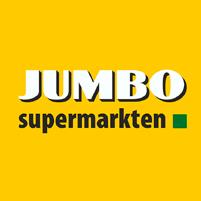
18 minute read
Jumbo Supermarkten
from May GRB C Edit
BY ELENA SULLIVAN

Advertisement
JUMBO SUPERMARKTEN Building on Innovation and Sustainability
Jumbo Supermarkten, founded in 1979, with headquarters in Veghel, Netherlands, is part of the privately-owned Van Eerd Group which was established in 1921. The second largest supermarket chain in the Netherlands, Jumbo entered the Belgium market in 2019. Jumbo has grown over the past few years, with the acquisition of several Dutch brands such as La Place, C1000 and Emté. The company now operates over 680 locations with more than 85,000 employees. The supermarket chain also has 444 pick-up points for online orders and 522 home delivery service locations. Jumbo’s sales have also grown, according to Statista.com, Jumbo’s turnover almost doubled from 2012 to 2020, increasing to about 9.6 billion euros by 2020. The retailer’s market share also grew and reported 21 percent of the market share in 2019.
Jumbo boasts a robust private label range under the ‘Jumbo’ name, which was introduced in 2008. With over 9,000 private label SKUs, the line includes groceries, desserts, and wines, just to name a few. The company places confidence in its consumers’ opinions which led it to set up a test lab to enable consumers to taste new products and provide feedback. Continuous innovation is also important to the retailer and in 2017, looking to create innovative products, Jumbo set up the Jumbo Innovation Lab to develop new and healthy food items in collaboration with suppliers and product developers. According to the company, this collaboration resulted in products including different flavoured single-serve oatmeal, kale burgers, and pumpkin balls to name a few.

The retailer continues to roll out on-trend private labels, including in recent years, additional SKUs to its Vegetarian line, Veggie Chef and a range of Asian inspired meals As well as most recently, a new premium line called Jumbo Gourmets, which includes high quality fresh meats and fish. Additionally, in mid-2020, Jumbo announced several private label initiatives to grow its already strong and varied portfolio. In recent years health and wellness have become increasingly popular to consumers and Jumbo has leaned into this trend with its private label offerings.
The retailer has been focusing on new healthier products and revamping its existing products to remove unhealthy ingredients. For example, Jumbo recently rolled out a successor to the Veggie Chef line, called Lekker Veggie, which included 42 different products including a plant-based schnitzel and falafel and a “first-to-market” plant-based stew. Continuing with the health trend, Jumbo has been reducing sugar and salt from many of its existing products. According to the retailer, it expects to reduce sugar by 4,000kg and salt by 3,000kg annually.
80 Locations 444 Pick-up points 522 Home delivery service locations
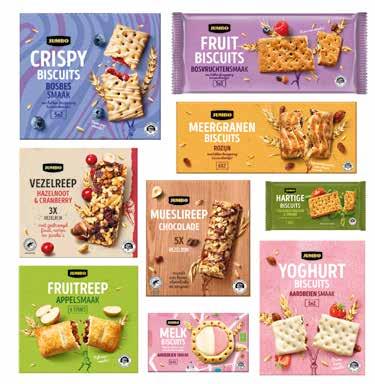

Sustainability Sells
Sustainability is a buzzword for many retail companies, including Jumbo. Jumbo prides itself on its efforts to be holistically sustainable as a company. The company works tirelessly to ensure that every aspect of its business works towards this goal. Its products, production business practices, and physical retail locations all encompass some aspects of sustainability. The company has been focusing on sustainability in its private label product ingredients and packaging and has recently engaged in several innovative initiatives. The retailer has been actively introducing more plant-based private label products which adhere to the idea of preserving the earth by consuming less meat. Additionally, the retailer is looking at ways in which it can incorporate environmentally friendly values into all aspects of its products, including its sourcing, and animal welfare. For instance, the retailer announced that it would add sustainable canned fish to its existing sustainably sourced private label fresh and frozen fish. Now, the retailer offers 96% of its fresh, frozen or canned private label fish with the MSC or ASC label. The canned fish contains the MSC label and includes eight products, ‘four tuna varieties (water, sunflower oil, olive oil, with vegetables in tomato sauce), anchovies, pink salmon, herring in tomato sauce and sardines’. Jumbo’s has also been expanding its range of dairy products that hold the ‘1 star Beter Leven’ label, rolling out five new products in the summer of 2020, including semi-skimmed milk, whole milk, semi-skimmed yogurt and buttermilk. The ‘1 star Beter Leven’ label indicates higher welfare products, with dairy products signifying that the animals are treated more humanely, with better living conditions. Many of Jumbo’s private label eggs, meat, meat products and snacks have the Beter Leven mark, illustrating the company’s efforts to be holistically sustainable.
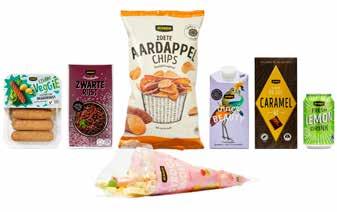

Jumbo first supermarket with only more sustainable milk

Jumbo opens the most sustainably designed supermarket building in the Benelux in Goor
Furthermore, Jumbo has also altered its packaging to also be more sustainable. The company notes that its products are “packed in a transparent tray made from 100% recycled PET bottles’, while the packaging sleeve is made of ‘FSC-certified cardboard and is almost halved compared to the previous sleeve’. Among many initiatives, Jumbo’s website claims that starting April 1, and continuing through Autumn, even more of its private label fruits and vegetable products will be offered in sustainable packaging that uses less plastic and some packaging will now be paper instead of plastic.
Jumbo has dedicated part of its website to offer detailed information on its efforts to become a more sustainable company, including its participation in Plastic Pack Netherlands with about 110 other companies and organizations in conjunction with the Dutch government. The Plastic Pack focuses on “innovations that reduce the use of plastic, enable reuse, ensure high-quality recycling and stop the pollution of our living environment,” according to its website.
Additionally, adding to its efforts in sustainability, just this September, the retailer launched the ‘Brood van Brood’ initiative as part of its Waste-Free Week campaign, which started on September 1st. The project involves the retailer making new white and wholemeal bread from unsold privatelabel bread. Making new bread from old bread is described by the retailer as an ancient bread making technique. It entails adding water and sourdough culture to the crumbled bread and placing it in special containers to allow the dough to form. Jumbo’s Waste-Free Week campaign was initiated in 2019 and ran from 1 to 7 September 2020. The campaign aims to bring attention to ways in which consumers can cut back on waste. Along with products sold at reduced prices, and discounted meal kits that were precisely proportioned, to help shoppers reduce food waste, Jumbo also shared recipes based on leftovers via online channels and social media. Jumbo saves hundreds of thousands of kilos of plastic per year with new packaging


As sustainability and caring for the environment is not a trend that will disappear anytime soon, Jumbo is at the forefront of innovation and constantly searching for ways in which its company can become even more sustainable. This effort will not only benefit its consumers, but have the ultimate goal of helping to preserve the Earth.
Online shopping has grown to an entirely new level due to the Covid-19 Pandemic as online shopping for some consumers became a necessity and not just a luxury. Even prior to the onset of the Global Pandemic, e-commerce was increasingly the choice of many shoppers, and many companies including Jumbo, were working to improve their online platforms and create a seamless online shopping experience for their consumers. Jumbo has been dedicated to improving its online platform to provide the most up-to-date technology to achieve this goal. In 2018, the company launched the Jumbo Technical Campus (JTC), where according to a company press release, “over 100 inhouse experts work daily to improve Jumbo’s digital applications. These experts develop B2B, B2C and mobile platforms, responsive web design, loyalty programs, and order management systems (OMS).” The company highlights the fact that it pays close attention
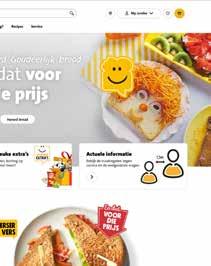
E-Commerce Takes Center Stage
to emerging eCommerce trends such as microservices and online marketplaces to provide its shoppers with the most current online technologies. Furthermore, the site architecture is in a constant state of development, with a strong focus on emerging eCommerce trends, such as microservices and online marketplaces.
Jumbo not only focuses on online technology but also strives to make both its in-store shopping and delivery experience easier for its consumers. In the past several months, the retailer has introduced an in-store shopping feature to support customers’ experiences and an increased delivery option to help those who want to shop online. In regards to in-store innovations, in December 2020, the company announced its partnership with NCR, a global provider of leading retail technology solutions. With NCR’s support, Jumbo will roll-out self-check solutions for all of its retail stores in Holland and Belgium. Self-check out is an important aspect of NCR’s Next Generation Retail Store Architecture that supports retailers in simplifying store operations and introducing new innovations quickly. The selfcheck out feature will add to Jumbo’s existing store technologies including NCR’s enterprise software platform R10 and NCR’s mobile scanning solution, NCR FastLane Mobile Shopper. Continuing with its technological advances to help consumers shop better and faster in-store, Jumbo recently announced that it is set to test a smart shopping cart featuring cameras, a touch screen, and artificial intelligence capabilities. The pilot will be introduced at its Jumbo Foodmarkt outlet in Veghel and will be used to determine if the initiative offers added value and a better experience for shoppers. According to Jumbo, the features that will be included are: the products are automatically scanned when placed in the cart, and the cart features a touchscreen on which customers can view their shopping list. Whatsmore, on the screen, shoppers can see the price of the products and which products are on sale. Jumbo hopes to add the ability to offer payment methods through the screen as well. The pilot phase will enable Jumbo to test the smart shopping cart and to alter or add features as needed. Additionally, the pilot phase is intended to determine if this innovation improves a shoppers experience and if the smart carts will become a permanent feature.

Yet another initiative Jumbo has rolled out to satisfy the increase of online shopping, as well as the demand for home delivery, is grocery delivery on Sundays. The service is now available to customers of approximately 250 Jumbo stores in northern and central Netherlands, North Brabant and Zeeland. Customers are charged 7.95 euros for the Sunday delivery and can place their orders until 23.59 on Friday evenings.

Future Endeavors
Jumbo Supermarkten’s dedication to innovation instore and online exemplifies just one of the reasons the retailer has become the second largest supermarket chain in the Netherlands. As the company continues on its mission to actively practice sustainability in all aspects of its business, as well as provide outstanding shopping experiences and quality private labels, we are sure to see Jumbo Supermarkten continue its expansion well outside of the Netherlands.
Photos courtesy of Jumbo

What Makes a Good Grocery Wine? An Epicurean Label?
I have a very good friend in Belgium who loves a good glass of wine, he is an epicurean above all. Discussing wines one time I asked him how he chooses his favorites. ‘I only look at the label he told me’, without a doubt, although I had to look through his poker face. No tasting, no nothing, just the attraction of the label. Gold lines, green leaves, eye-catching images, he filled in the taste of the wine according to his expectations the front of pack evoked. Of course sometimes it didn’t work out that well. Life is simple, just don’t buy that bad one anymore, up to the next.
It reminded me of the famous behavior trial of researcher Brian Wansink from the Food and Brand Lab at Cornell University. He offered guests in an experimental restaurant setting the same grocery wine, but the researcher put the liquid in bottles with different labels. The wines were placed in plain sight at the dining table, as part of the meal. One bottle with a label from the sunny state of California, the other from the snowy American state of North Dakota. In the end the laboratory rabbits not only appreciated the taste of the Californian wine better than the Dakota wine, they also liked the food better as well as the whole of the eating experience.

Choosing at the grocery
In the experiment the guests were firmly influenced just by the region on the label. However, sitting with friends or family at the dinner table is a different story than choosing and judging wine in front of the waterfall of wines on grocery shelves. Only less than 30 seconds an average customer spends in the wine aisle to make up his mind. The visual language on the bottle is crucial.
A study conducted in South America analyzed the purchase intention of 114 individuals, half of them man, half women. In front of the wine shelves of a simulated supermarket they were observed for a few minutes and their eyes were tracked. The study confirms the label can be highly positive in suggesting the purchase intention. It differentiates between womean, men, experts and non-experts. Not surprisingly, experts always seek for all the details, while non-experts can be confused by it, the latter doesn’t positively influence the purchase. Still it is the combination of the denomination of origin and health


warning that gives the general consumer some signal to make a decision. Women, compared to men, are more guided by the sense of vision and are more prone to reading labels. They especially rely on nutritional information, sometimes in combination with other aspects of the label.
Neuromarketing
To better understand the unconscious shopping mechanisms of consumers as far as shelf placement, appeal and recognizabillity of the label, recently the Italian wine maker Cantina Tollo carried out a neuromarketing research in collaboration with the University of Pescara and Chieti. The results led to the development of a new series of labels for the Rocca Ventosa line. With each element of the label the winemaker wants to tell the consumer about a particular wine and the winery in the Abruzzo region. ‘Neuromarketing has helped us understand some crucial elements, thus allowing us to find the right key for the restyling, a strategic differentiation in approach that brings us closer to the consumer’, says Andrea di Tollo, general director of Cantina Tollo. ‘The time spent in front of the shelf is definitely shorter. Based on this, and considering the extremely huge offer consumers can choose from, it’s important to catch their attention and bring them towards us. Packaging plays a key role in this process.’
For Tollo the new packaging was a turning point decision and not an easy task, given the fact Rocca Ventosa is a traditional brand. Without change nothing happens. If you ask me how I choose wine, I can’t pass by the label either. I first look at the grape variety and the region, but if the label even promises an epicurean experience, I’m in. Hans Kraak is educated in biology and journalism and wrote two books about nutrition and health. He worked for the Dutch ministry of Agriculture, Nature and Food quality and the Netherlands Nutrition Centre. As editor in chief he publishes in Voeding Nu, a business to business platform on food and health, as a food and wine writer he publishes in Meininger’s Wine Business International and reports for PLMA Live EU and PLMA USA.

Reducing Materials To Design Eco-Friendly And Sustainable Laundry Packaging
SGK Amsterdam, Vrijdag Premium Printing, Generous Minds, Neurensics, Kurz, Merck and Haval have joined forces under the name ‘Packadore Collective’ to design and implement both desirable and sustainable packaging solutions. Their ‘White is the new green’ design innovation explores how reducing materials can provide an eco-friendly and sustainable packaging solution.
Traditionally, all laundry detergent brands were sold in large carton boxes and while such formats are still widely in use, consumer preference has lent towards gels and pods in recent years, thus increasing the volume of plastic packaging used — whether virgin or recycled.
Carton is a highly renewable material with a relatively low eco-cost; it can be recycled 7-8 times before it loses its integrity and therefore its value. Brands of course need a canvas in which to distinguish themselves and communicate with their consumers on pack, but the use of ink printed on carton and paper material significantly reduces its sustainable benefits.
‘White is the new green’ conceptual packaging design innovation imagines an ink free carton packaging format, using embossing to maintain brand communication and to amplify the brands sustainable credentials. During manufacturing, die cutting and embossing happen as part of the same process and so no additional step or change to the line set-up is required. In addition, this ‘cleaner’ packaging design and use of white itself becomes a strong communication cue in terms of supporting the product’s proposition, a cleaner pack for cleaner laundry — simplifying the design to help amplify the impact. By removing the need for ink, we can enhance the consumer packaging experience and help brands to navigate the circular economy maze.
If orange is the new black, white is the new green.
Taking this one step further as part of our consumer neuroscience research, we have explored the impact and effectiveness that such desirable and sustainable packaging designs can have, as compared to a benchmark of existing packaging already in the market — one that we know to be performing well. Our mission is to understand if brains really do ‘buy green’.
We all know the saying, ‘do as I say, not as I do’ and this rings especially true when looking at the challenges of more traditional forms of consumer research; consumers say one thing and do another. We need better methods of qualifying our investments in packaging design, especially when moving towards more sustainable solutions.
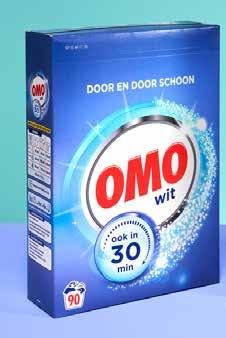

Consumer behaviours, including purchasing behaviours, are influenced by unconscious processes. Our goal here is to understand and validate consumer perceptions and preferences in order to confidently predict consumer behaviours and choices — in store and online. This approach can be used to help reduce risk when making significant step changes.


NETWORKS OF THE BRAIN
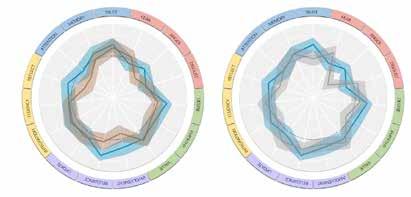
Using MRI scanning, we measured the brain activations of 24 respondents in response to the three different packaging solutions. We then analysed a range of emotional responses linked to purchase intentions; positive emotions such as desire, expectation and trust, but also negative emotions such as fear, aversion and irritation.
The results are highlighted below:
The Omo benchmark packaging design scored high on trust, relevance, value and desire and had lower than category average scores on the more negative emotions. This is to be expected given consumers were presented with a strong and familiar brand — indeed, a brand leader in the Netherlands. purpose driven communications campaign. Interestingly, anger was non-existent — dropping well below both the benchmark and the category average. This indicates a removal of previously seen levels of irritation associated with the bold bright colours of the benchmark. The white packaging instead offers a high level of serene pleasure while maintaining the same attention levels.
Brands such as Unilever’s Omo are committed to taking steps towards a more sustainable future — such steps are not a ‘nice to have’ but a necessity in order to both meet Government regulations and to protect our environment. This exercise has been driven by a desire to learn more about how such brands can navigate the circular economy maze whilst still maintaining desirability.
We have seen that similarly high levels of value, desire and relevance perceptions can be secured with a more eco-friendly yet bold packaging solution as with our white conceptual packaging design. The white packaging design evokes a very similar brain pattern to that of the benchmark which qualifies the incredible potential to do more in aid of sustainability.
The unwritten rule in design for large brands such as Omo is ‘evolution’ not ‘revolution’ but our research results indicate that well established brands can take such steps with confidence. By leveraging existing elements of recognition and amplifying the sustainable credentials of the packaging, brands such as Omo can evolve to offer more sustainable and desirable packaging solutions while maintaining their status in market.
This conceptual design innovation exercise has been conducted by Packadore Collective under their own initiative and is not representative of a commissioned assignment by Omo brand owner Unilever.
About Packadore Collective:
Packadore Collective work collaboratively to design and implement both desirable and sustainable packaging solutions to help brands create real impact, now and for the future.
We are the innovators in temptainability.
Our brown conceptual pack scored equally high on trust and value but slightly less so on relevance and desire whilst maintaining low scores on negative emotions; including a particularly low score for anger, well below that of the benchmark. This indicates a low level of irritation in the consumers’ mind. Associations of brown paper with sustainability could also be at play here.
Our white conceptual pack received similarly high scores on value, relevance and desire but slightly less so on trust and also fear saw a slight increase; again, something to be expected given the packaging design is unfamiliar and of course easily overcome when supported with a








